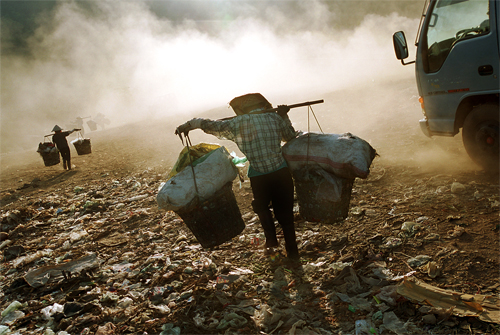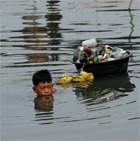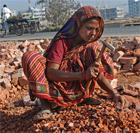| |
Poverty has many faces. Nearly two-thirds of the world’s 6.6 billion population lives in Asia. Over 500 million people in the Asia-Pacific region live in slum conditions, representing 60 per cent of the entire world’s slum residents. They typically suffer from lack of proper housing, low paying jobs, little or no education for children, lack of clean, safe water and hygiene; they have no means to help them climb out of this vicious cycle.
On a trip to Bangladesh over a year ago I spent some time in a slum community in the capital of Dhaka where over a hundred families lived in bamboo and thatch shelters that could barely withstand the effects of the monsoon rains.
These one-room shelters were cramped inside, with a dirt floor that was more often muddy than dry. Often two to three families shared the rooms.
The water source for the community was one stand-pipe near the end of the pathway near the river. Nearby, an open sewer ran the length of the community. Long queues, mostly women, stood in line waiting with their children, each carrying a bucket.
One young mother, cooking over an open fire, told me that life was harsh with little money for food. She worked long days, chipping bricks into small pieces used for roadways, earning less than a dollar a day. “It’s enough for rice each day, that’s all.”
I’ve seen poverty up close and felt the misery of those who live in its clutches. I remember on a trip to a settlement community in Manila, a young boy in the blackened water, half his face submerged as he tugged at a plastic bowl containing bits of plastic and metal he had collected. His rubber sandals floated next to him.
He would make little money on what he collected, but to him it was vital. It meant he could earn some money to help his family, and there are millions of children and adults just like him who survive on what is discarded.
Later that day I visited a dump site in Manila where scores of children and adults sifted through the garbage, looking for anything to salvage midst this surreal setting of burning tires and black sooty smoke rising above the site. Like the young boy in the water the small amounts they earn mean a lot to them because life in poverty is a fight for survival on a day- to-day, hand-to-mouth basis.
Throughout Asia the poor share a common trait in nearly every country in the region- a limited access to land. In rural cities squatter communities with large populations often exist for years but at some point are often evicted, and (only if they are lucky) may be relocated in remote locations some distance away, creating further burdens on access to work.
The “cities with slums” target set under The UN Millennium Development Goals calls for a significant change in the lives of at least 100 million people living in sub-standard conditions by the year 2020, to lift them out of the cycle of poverty and give them the chance to live with dignity and hope for the future. •

|
|




|
|













